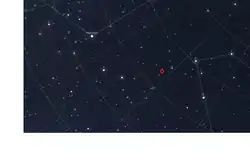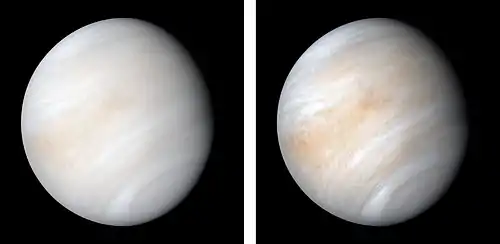HD 191939
HD 191939 is a single yellow (G-type) main-sequence star, located approximately 175 light-years away in the constellation of Draco, taking its primary name from its Henry Draper Catalogue designation.
 Location of HD 191939 in the night sky. The star is marked within the red diamond. | |
| Observation data Epoch J2000.0 Equinox J2000.0 (ICRS) | |
|---|---|
| Constellation | Draco |
| Right ascension | 20h 08m 5.75s[1] |
| Declination | +66° 51′ 2.1″[1] |
| Apparent magnitude (V) | 8.971[2] |
| Characteristics | |
| HD 191939 | |
| Evolutionary stage | main sequence |
| Spectral type | G8V[3] |
| Astrometry | |
| Radial velocity (Rv) | +9.266±0.0018[1] km/s |
| Proper motion (μ) | RA: +150.256[1] mas/yr Dec.: −63.909[1] mas/yr |
| Parallax (π) | 18.6247 ± 0.0253 mas[1] |
| Distance | 175.1 ± 0.2 ly (53.69 ± 0.07 pc) |
| Absolute magnitude (MV) | 5.32 |
| Details[3] | |
| HD 191939 | |
| Mass | 0.92 M☉ |
| Radius | 0.945 R☉ |
| Luminosity (visual, LV) | 0.69 L☉ |
| Surface gravity (log g) | 4.44 cgs |
| Temperature | 5427 K |
| Metallicity [Fe/H] | −0.16 dex |
| Rotational velocity (v sin i) | 0.6 km/s |
| Age | 7±3 Gyr |
| Other designations | |
HIP 99175, TYC 4244-964-1, USNO-A2 1500-07227721, 2MASS J20080574+6651019, Gaia DR2 2248126315275354496, TOI 1339 | |
| Database references | |
| SIMBAD | data |
| Exoplanet Archive | data |
| Extrasolar Planets Encyclopaedia | data |
Characteristics
HD 191939 is a Sun-like G-type main-sequence star, likely older than the Sun and relatively depleted in metals.
Planetary system
In 2020, an analysis carried out by a team of astronomers led by astronomer Mariona Badenas-Agusti of the TESS project confirmed the existence of three gas giants,[3] all smaller than Neptune, in orbit around HD 191939. Another non-transiting gas giant planet designated HD 191939 e was detected in 2021, along with a substellar object on a highly uncertain, 9 to 46 year orbit.[4]
| Companion (in order from star) |
Mass | Semimajor axis (AU) |
Orbital period (days) |
Eccentricity | Inclination | Radius |
|---|---|---|---|---|---|---|
| b | 10.4±0.9 M🜨 | 0.078±0.001 | 8.88029±0.00002 | 0 | 88.06±0.08° | 3.39±0.07 R🜨 |
| (unconfirmed) | <6 M🜨 | — | 17.7 | — | <88° | — |
| c | 7.2±1.4 M🜨 | 0.170±0.002 | 28.5805±0.0002 | 0 | 89.09±0.03° | 3.08±0.07 R🜨 |
| d | 2.7±1.5 M🜨 | 0.207±0.003 | 38.3525±0.0003 | 0 | 89.43±0.04° | 3.04±0.07 R🜨 |
| e | 108±3 M🜨 | 0.397±0.005 | 101.5±0.4 | 0 | 88.7±0.7° | — |
| f | 2~11 MJ | 2.6~7.0 | 1700~7200 | — | — | — |
References
- Brown, A. G. A.; et al. (Gaia collaboration) (August 2018). "Gaia Data Release 2: Summary of the contents and survey properties". Astronomy & Astrophysics. 616. A1. arXiv:1804.09365. Bibcode:2018A&A...616A...1G. doi:10.1051/0004-6361/201833051. Gaia DR2 record for this source at VizieR.
- news.sky-map.org HD 191939 data
- Badenas-Agusti, Mariona; Günther, Maximilian N.; Daylan, Tansu; Mikal-Evans, Thomas; Vanderburg, Andrew; Huang, Chelsea X.; Matthews, Elisabeth; Rackham, Benjamin V.; Bieryla, Allyson; Stassun, Keivan G.; Kane, Stephen R.; Shporer, Avi; Fulton, Benjamin J.; Hill, Michelle L.; Nowak, Grzegorz; Ribas, Ignasi; Pallé, Enric; Jenkins, Jon M.; Latham, David W.; Seager, Sara; Ricker, George R.; Vanderspek, Roland K.; Winn, Joshua N.; Abril-Pla, Oriol; Collins, Karen A.; Pere Guerra Serra; Niraula, Prajwal; Rustamkulov, Zafar; Barclay, Thomas; et al. (2020). "HD 191939: Three Sub-Neptunes Transiting a Sun-like Star Only 54 pc Away". The Astronomical Journal. 160 (3): 113. arXiv:2002.03958. Bibcode:2020AJ....160..113B. doi:10.3847/1538-3881/aba0b5. S2CID 211069628.
- Lubin, Jack; et al. (2021). "TESS-Keck Survey IX: Masses of Three Sub-Neptunes Orbiting HD 191939 and the Discovery of a Warm Jovian Plus a Distant Sub-Stellar Companion". arXiv:2108.02208.
This article is issued from Wikipedia. The text is licensed under Creative Commons - Attribution - Sharealike. Additional terms may apply for the media files.


_on_Jul_14_2020_aligned_to_stars.jpg.webp)


